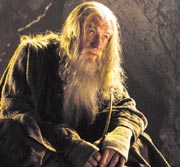THE LORD OF THE RINGS: THE FELLOWSHIP OF RINGS
directed by Peter Jackson with Elijah Wood, Ian McKellen, Cate Blanchett, Gwyneth Paltrow, Ben Stiller, Viggo Mortensen, Liv Tyler, and Ian Holm opens Dec. 19 at Cinerama, Metro, Pacific Place, and others
HERE’S A SHOCK: Lord of the Rings rocks. What could’ve been a geek spectacle for the D&D set, what could’ve killed New Line Cinema with its cost, what could’ve been a safe, bland Harry Potter-style franchise builder is instead the most vital cliff-hanger since the 1977 Star Wars. Easily the best three-hour movie this year, certainly a better three-hour movie than Titanic, this first installment of a trilogy to continue the following two holiday seasons accomplishes its daunting task convincingly: You can’t wait to see the next pair of Middle-Earth epics.
Moreover, the challenge met by director Peter Jackson in Fellowship is not just to entertain and whet our appetites for LOTR parts II and III but to lay out J.R.R. Tolkien’s whole mythic universe. For the uninitiated who haven’t read the whole damn opus or who don’t frequent various LOTR Web sites to debate the finer points of Tolklore, it goes something like this: Living in the idyllic green Shire, hobbit Frodo (The Ice Storm‘s Elijah Wood) inherits a magical ring from his uncle Bilbo (Ian Holm). Informed by the wizard Gandalf (Ian McKellen) of the ring’s evil powers (coveted by frightening pursuers), Frodo joins Gandalf and seven others on a perilous journey to destroy the ring by casting it into a volcano—inconveniently located in hellish Mordor, where chief bad guy Sauron dwells.
The species-integrated fellowship includes a token elf and dwarf, plus two humans: one steadfast (Viggo Mortensen, 28 Days); the other suspect (Sean Bean, Ronin). Frodo’s also got three hobbit pals for comic relief. Along the way, our band encounters kindly elf princesses—is there any other sort?—played by Cate Blanchett and Liv Tyler.
Appropriate to Tolkien’s scholarship in ancient epics like Beowulf, Fellowship is basically a quest narrative with a moral streak. Diminutive Frodo is the unlikely, somewhat timorous hero who’s counseled by wise Gandalf. Quicker than you can say “Obi-Wan Kenobi,” the Star Wars parallel is clear, but one must recall that Tolkien, by way of Joseph Campbell and others, is the real influence upon George Lucas. If the ring represents determinism, Gandalf reminds Frodo, free will is still possible: “Decide what to do in the time that is given you.”
SUCH ADAGES ARE essential to Tolkien, and while Jackson has abridged some of Fellowship‘s characters and plot, his trims respect the material. He wisely limits all the exposition—character introductions, the ring’s history, Gollum, etc.—to short flashbacks between regular chases, sword fights, and monsters. These traditional motion picture staples keep Fellowship from becoming bogged down by feasts, hobbit hug fests, and flute music (although, be warned, they’re still there). Also, because Tolkien’s volumes are page-turners originally intended for the attention spans of young readers, Jackson inherits the same inherently movie serial-like structure that Lucas revived in Star Wars.
Thus, after a mercifully brief spoken prelude, Jackson quickly cuts to a rousing CGI battle scene, intent on establishing that Fellowship is a bona fide action-adventure film. There, an army of men and elves combats an armada of trolls and orcs. (What’s an orc? Basically a zombie with bad teeth, befitting Jackson’s horror flick background.) Jackson periodically sends the camera swooping Sam Raimi-style through the action or high above snowy mountains, evil castles, and sulfurous mines. In this way, Tolkien is turbocharged, saved from his musty rhetoric and repetitiousness, and booted straight into the Matrix era.
Yet Star Wars remains Fellowship‘s main point of comparison—like the child you met long before encountering the similar-looking parent, prompting a gasp of recognition. Sci-fi and fantasy have always been related, but Lucas cannily opted for the streamlined future over the freighted past. Fellowship is both atavistic and prophetic, gazing backward and forward at the same time.
Without the benefit of explosions or light sabers or X-Wing fighters, Fellowship faces a tougher job winning viewers born after ’77 than wooing their hobbit-loving parents. Lucas was able to create his own following, while Jackson has to stick (mainly) to the original text to please Tolkien’s cult (which limits the trilogy’s upside). Given its sheer narrative bagginess, Fellowship can’t quite match the distilled genius of Lucas’ original. Yet Fellowship is finally a tremendously exciting, satisfying movie-movie in the best sense. Its appeal should reach well beyond medievalists and Myst enthusiasts, and its auspicious beginning now gives the entire series the promising look of a classic.








